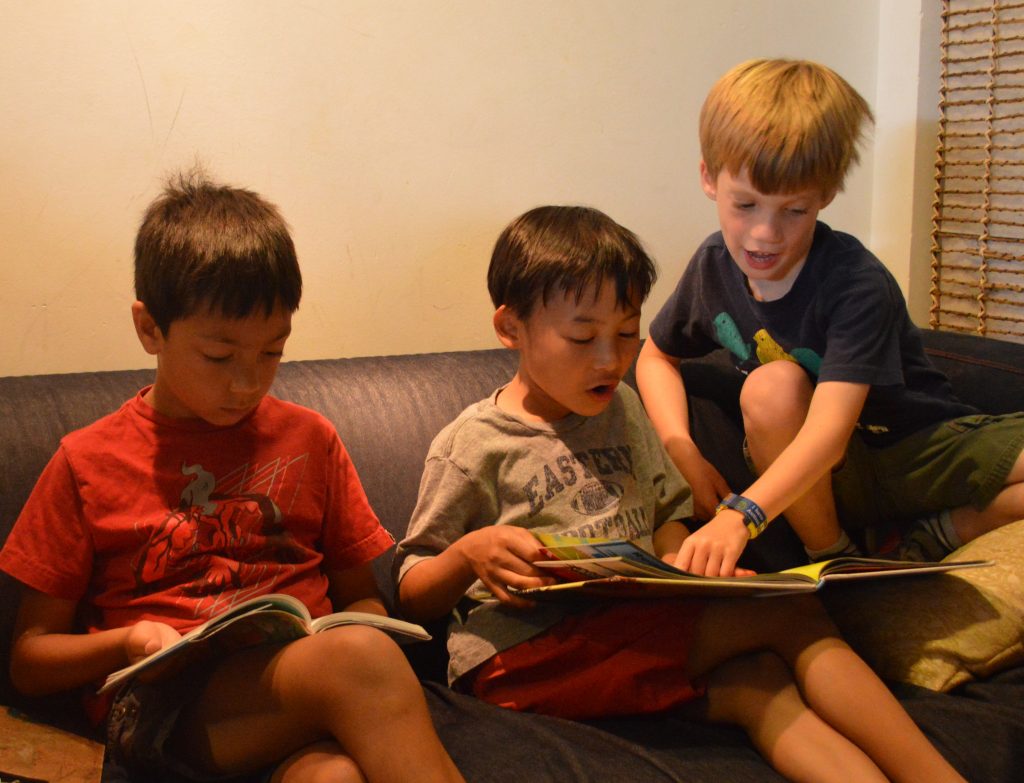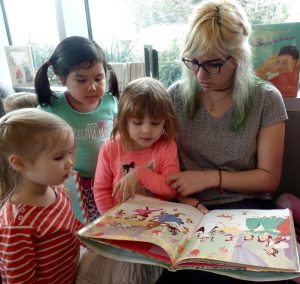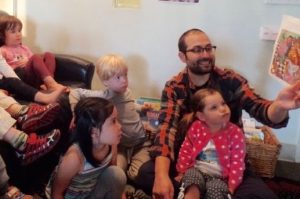
Authentic Literacy Learning
by Bria Bloom, Educator, Hilltop Children’s Center
Marissa and Casey sat on the couch, reading There’s a Wocket in My Pocket, together. This Dr. Seuss book is filled with fun and silly rhymes, which catch children’s attention and aid in their sound recognition and natural memorization ability. As they flipped through the pages, they took turns reading aloud, and echoes of “There’s a Zower in the shower!” and “A Noothgrush on my toothbrush” rang through the room. They were not randomly repeating phrases they remembered on random pages, but were using the pictures to spark their memory of what happens in the book and saying the phrases that they had memorized and interpreted as being associated with each picture.
 As in the story, children memorize favorite phrases (at times even whole books), and as they repeat their memorized script, they will visually scan the words and pictures on the page, which allows them to connect the words in their memories to the ones they see in the book. It is helpful to introduce children to patterns and repetition in multiple contexts, such as reading the same books over and over, or pointing out letters on signs as we walk or drive through the city. This is why Dr. Seuss and other rhyming books are helpful; they give the children patterns to recognize and remember. As children spend time with their favorite books, they begin to recognize letters and sounds in the words.
As in the story, children memorize favorite phrases (at times even whole books), and as they repeat their memorized script, they will visually scan the words and pictures on the page, which allows them to connect the words in their memories to the ones they see in the book. It is helpful to introduce children to patterns and repetition in multiple contexts, such as reading the same books over and over, or pointing out letters on signs as we walk or drive through the city. This is why Dr. Seuss and other rhyming books are helpful; they give the children patterns to recognize and remember. As children spend time with their favorite books, they begin to recognize letters and sounds in the words.
Children’s desire to learn to read is driven in the same way as their desire to learn to talk — they are naturally curious, they want new ways to communicate, and they imitate the adults around them. Because the desire to learn to read starts first and foremost with imitating adults, the most important influence for children results from seeing their family members read, and having those adults explain their enjoyment. Read to children often, share positive reading experiences with them, and they will want to learn to read.
The key to developing literacy is a love of reading that is best stimulated by frequent exposure to letters and books. Reading activities that are forced on children can transform a delight into work. It is best to follow a child’s lead in when, what, and how they want to engage with books and letters, while still offering them ample opportunities in various contexts.
 This isn’t to say that if a child wants to do letter worksheets and look at flash cards you should discourage them. As long as you follow your child’s lead, any reading activity will continue to be a delight, as opposed to a chore. An important (and fun) early literacy skill is phonemic awareness. (Dr. Seuss’ first book, The Cat in the Hat was written precisely to enhance phonemic awareness.) Phonemic awareness, one of the initial reading skills, is the ability to hear, identify, and manipulate various sounds in words. Phonemic awareness includes rhyming, beat keeping, word and sound pattern recognition, and alliteration.
This isn’t to say that if a child wants to do letter worksheets and look at flash cards you should discourage them. As long as you follow your child’s lead, any reading activity will continue to be a delight, as opposed to a chore. An important (and fun) early literacy skill is phonemic awareness. (Dr. Seuss’ first book, The Cat in the Hat was written precisely to enhance phonemic awareness.) Phonemic awareness, one of the initial reading skills, is the ability to hear, identify, and manipulate various sounds in words. Phonemic awareness includes rhyming, beat keeping, word and sound pattern recognition, and alliteration.
What you can do to encourage early literacy
Rather than emphasizing structured activities that can turn reading into a chore, it is more effective to engage a child in spontaneous activities that they will find fun and silly, while teaching important foundations of reading. The beauty of activities that are effortlessly woven in to car trips, walks, and other daily experiences is that they are enjoyable, and rooted in the context of the children’s lives.
- Use rhymes. A classroom favorite is a nonsense rhyme, which involves the child’s own name — a motivator for children learning letters, reading, and spelling. In this rhyme (you may have heard it) you take a child’s name, Casey, for example, and create a song/rhyme: “Casey, Casey bo-basey, banana-fana-fo-fasey ,fi-fy-mo-masey, Cas-ey!” As you can see, this involves rhyming, alliteration, and clear separation of syllables.
- Create sentences or songs that involve alliteration. We also use names in this exercise (again, kids LOVE using their names!) We create silly or more realistic nicknames using alliteration. Some favorite examples in the past have included “Moomy Matt,” and “Lobster Leah.” The words can be made-up or real, as long as they start with the same letter as the child’s name. Three-year-olds will often need examples and prompting.
- For a listening skill, drop in extra words or change words in a song and see the children’s reactions. If they say “That’s not how it goes!” or “You are supposed to say it like this,” they are demonstrating their depth of listening, recognition, and memory skills.
- Read illustrated song books, such as Down by the Bay, or Old McDonald Had a Farm. This helps attach visual words, letters, and pictures to words that they have already memorized in sound.
What other natural and authentic ways have you found to incorporate pre-literacy skills like reading stories, noticing letters, rhyming games, alliteration, and phonemic awareness into your days with children?
Resources:
Here’s an article about phonological awareness, its importance, and ways to help build this awareness with young children, which suggests that “for young children, developmentally appropriate phonological awareness activities are a form of play. Riddles, games, singing, and dramatization will bring on laughter, silliness, and experimentation.” https://www.naeyc.org/files/yc/file/200901/BTJPhonologicalAwareness.pdf
And here’s an article about the importance of storytelling for young children: http://www.naeyc.org/yc/files/yc/file/200203/Isbell_article_March_2002.pdf
[author] [author_image timthumb=’on’]https://hilltopcc.com/wp-content/uploads/2016/02/Bria-bio-photo-e1456787923869.jpg[/author_image] [author_info]Bria Bloom is an educator with 2- and 3-year-olds at Hilltop Children’s Center, where she has worked since 2012.[/author_info] [/author]